
All categories
Featured selections
Trade Assurance
Buyer Central
Help Center
Get the app
Become a supplier

(703 products available)














































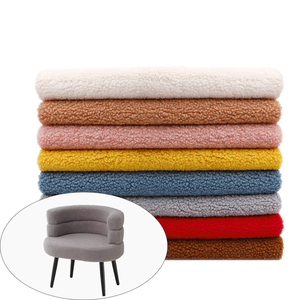
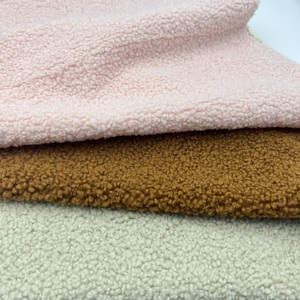
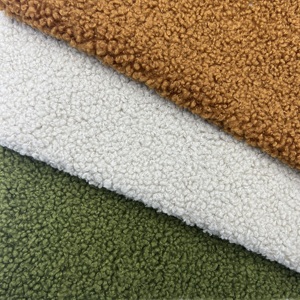
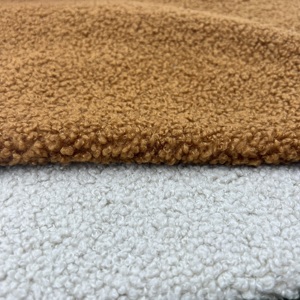
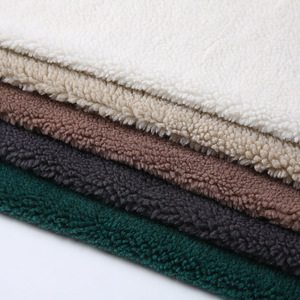
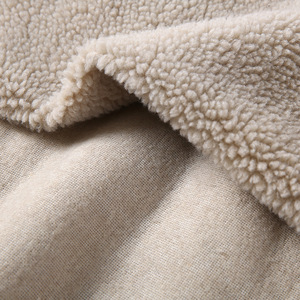

The textile raw materials used to create teddy bear fleece fabric consist of different types, each possessing unique properties and advantages.
Polyester Teddy Bear Fleece
Polyester teddy bear fleece is a synthetic fabric made from polyester fibers. Polyester is durable and wear-resistant. Therefore, the fleece is often used in children’s apparel and blankets, as it can withstand frequent washings without losing its new-like appearance. The fleece teddy bear fabric is plush and soft and can be manufactured in various colors. Often, these colors include vivid ones that are more difficult to achieve with natural fibers. In addition, polyester fleece is wrinkle-resistant and quick-drying. Thus, it requires minimal care for those items and, consequently, allows for practical use.
Blended Teddy Bear Fleece
Blended teddy bear fleece is made from a blend of materials. For instance, cotton and acrylic have combined the best qualities of each fiber. Blended fleece is softer and more breathable than pure polyester, making a more comfortable fabric for clothing and home textiles. In addition, blends can be more cost-effective than pure natural fibers while providing some of the softness and durability characteristics of organic materials. This fleece is also more sustainable, often manufactured from recycled materials, including post-consumer plastic bottles.
Organic Cotton Teddy Bear Fleece
Organic cotton teddy bear fleece is produced from organically grown cotton without synthetic pesticides or fertilizers. This fleece is softer and more breathable than synthetic options and a healthier choice for the environment. Since it is produced of natural materials, organic cotton fleece is also hypoallergenic and suitable for sensitive skin. Due to its softness and safety properties, it can also be used in baby clothing and blankets. However, it is less durable and requires more care.
Recycled Teddy Bear Fleece
Recycled teddy bear fleece is manufactured from post-consumer plastics, such as plastic bottles. This eco-friendly option allows synthetic fleece to be enjoyed without waste. The recycled material has the same durability and resistance characteristics as original polyester but with a lower environmental impact.
Teddy bear fleece fabric features various types, each possessing unique characteristics and benefits.
Super Soft and Plush Texture
The most notable characteristic of teddy bear fleece fabric is its extremely soft texture. It is super soft and plush, which makes it appealing to end consumers. This texture range is often used in children's products, such as toys, and is also desired in clothes and home textiles like blankets and throws. The softness provides comfort and luxury and gives the fabric a cozy touch that quickly becomes irresistible.
Warmth and Insulation
Teddy bear fabric provides exceptional warmth and insulation with its thick, fluffy surface. It traps air and creates good heat retention, making it excellent for cold-weather apparel and blankets. Thus, it is ideal for providing warmth during winter. Also, the fabric is commonly used to manufacture outdoor gear for hiking and camping in cold conditions.
Lightweight yet Thick
Teddy bear fleece fabric feels thick and plush but remains lightweight. This quality makes it extra comfortable to wear or use without adding excess bulk. For example, jackets, sweaters, and blankets can provide users with warmth but limit mobility and heavy weight. Such a combination is desirable in fashion and home goods markets.
Easy Care and Durability
Teddy bear fleece fabric is usually machine washable, which is easy to care for. It retains its texture and color well after frequent washing, making it a practical choice. Its durability allows it to hold up under normal use and in items requiring frequent cleaning, such as children's goods and pet accessories.
No Shedding or Pilling
Many fleece fabrics have a tendency to shed or pill over time. However, teddy bear fleece rarely experiences this problem. It makes it a desirable choice for designers and consumers. They prefer a fabric that will maintain a new-like appearance over extended use. This quality is particularly important in home textiles, where customers want their throws and blankets to look aesthetic even after years of use.
Stretch and Flexibility
Stretch is another important property of bear fleece fabric. It is flexible enough to allow freedom of movement, making it suitable for apparel. This feature is especially useful for garments such as hoodies and pajamas, where comfort and ease of movement are essential.
Teddy bear fleece fabric has a wide application. Below are some of its many uses.
Apparel Manufacturing
The ultra-soft fleece teddy bear material is popular for building warm, comfortable clothes such as sweatshirts, pajamas, and winter coats. It is especially preferred in the children’s and baby clothing lines due to its hypoallergenic nature and softness. Adults also wear it for loungewear and sleepwear. They appreciate the fabric's warmth and lightness. Furthermore, designers favor this fleece in activewear because it stretches and allows easy movement.
Home Textiles
Teddy bear fleece adds comfort and style to home textiles such as blankets, throws, and cushions. It is often used in making cozy blankets that provide warmth during cold weather. Teddy bear fleece fabric is also prevalent in home décor items. It adds a luxurious touch without the high cost associated with natural fibers. This fleece is stain-resistant, easy to care for, and machine-washable, ideal for many home applications.
Pets Products
The soft and durable nature of teddy bear fleece makes it excellent for pet products. They range from pet blankets, beds, and toys. Pets love the plush texture, which offers them comfort while curling up or playing. In addition, the fabric is durable enough to withstand wear and tear from chewing or scratching. Thus, it is ideal for pet owners seeking quality products for their furry friends.
Craft and DIY Projects
Teddy bear fleece is a staple in various crafting and DIY projects. Crafters commonly use it to create stuffed animals, plush toys, and dolls. The fabric is easy to sew, and its stretchiness allows the creation of items that are snug and well-fitted. Also, it comes in a wide range of colors and patterns. This variety gives artisans much freedom to create unique, custom-made fleece items.
Linings for Accessories
Teddy fleece is also used as lining in various accessories. They include hats, gloves, and scarves, for added warmth and comfort. This fleece provides a cozy feel against the skin while retaining heat. Thus, it enhances the function and comfort of cold-weather gear. It is also used in footwear linings, such as boots and slippers, to keep the feet warm and comfortable.
The following factors should be considered by buyers who wish to stock up on teddy bear fleece fabric.
Material Composition
Fleece fabric bears close resemblance to each other in terms of softness and texture. However, they differ in durability, warmth, and stretch levels. Buyers should inquire about the composition of the fleece. Is it pure polyester or a blend with other materials like nylon or spandex? Each material comes with its own unique benefits. For instance, pure polyester is warm and lightweight, while a spandex blend adds elasticity. These details have to be considered when choosing a specific fabric for a project.
Texture and Finish
Teddy bear fleece is usually available in two different finishes. They are the textured side and the smooth one. The former offers a more fluffy feel. On the other hand, the later looks more sleek and polished. Buyers should stock both finishes to satisfy the needs of different customers. Also, they should pay attention to the texture of each fleece, as some may be softer than others. The softness level significantly impacts customer satisfaction since the material is designed for making cozy clothing and accessories.
Weight & thickness
Fleece fabrics are manufactured in varying thicknesses and weights. They range from light to heavy. Generally, the heavier the fleece, the warmer it would be. Typically, lighter weight fleece is ideal for customers seeking loungewear or sleepwear for moderate temperatures. On the flip side, heavier fleeces are better for winter wear. Buyers have to stock various weights and thicknesses to cater to customers who desire specific warmth levels.
Colorfastness and Patterns
The color of teddy bear fleece plays a pivotal role in making it attractive to buyers. Typically, this fabric is widely recognized for its bold and bright colors. Therefore, buyers have to get fleeces with vibrant and stunning colors that can also blend well in home décor. They should also look for patterns that will remain trendy, such as geometrics. In addition, teddy bear fleece cloth should possess good colorfastness. This quality will prevent the fabric from fading, especially when exposed to multiple washes.
Sustainability and Care Instructions
Eco-conscious consumers are also making up a big part of the market. Therefore, buyers should consider fabrics that are made with recycled materials. Also, they should ensure to get fleeces that are easy to clean, ideally those that are machine-washable. They should also be on the lookout for care instructions. Some teddy bear fleeces are manufactured to resist shedding and pilling, features that will surely endear the fabric to customers who prefer low-maintenance items.
Teddy bear fleece fabric is an ultra-soft textile commonly used for making plush toys, blankets, and clothing. It has a cozy texture that feels gentle on the skin. Therefore, this fabric is durable, lightweight, and easy to care for. It also comes in various colors and patterns. This variety makes it popular for home décor and crafting projects.
The apparel industry uses teddy bear fleece to manufacture loungewear, pajamas, and outerwear. The home textiles industry uses it to create blankets, throws, and upholstery items. Children’s markets also commonly feature this fabric in clothing. Lastly, the crafts industry uses it in DIY projects like stuffed animals and home décor.
The thickness of teddy bear fleece fabric normally ranges from 200 to 300 GSM. This range gives the fabric a plush, cozy feel without adding excess bulk. This thickness is ideal for various applications. They include apparel, where warmth, comfort, and flexibility are required.
The majority of teddy bear fleece fabrics are manufactured from polyester. This synthetic fiber provides durability, easy maintenance, and resistance to shrinking and stretching. Certain teddy bear fleeces blend organic cotton with polyester. They enhance the fabric’s softness and breathability. This blend makes it feel more like natural fibers against the skin.
Consumers can maintain the quality of teddy bear fleece fabric by following some simple care tips. For instance, they should wash it in cold water using a gentle cycle and avoid bleach. Also, they should tumble dry the fabric on a low heat setting or hang it to dry and prevent pilling by occasionally brushing it with a soft fabric brush. Lastly, they should store the fleece in a cool, dry place away from direct sunlight to prevent color fading.